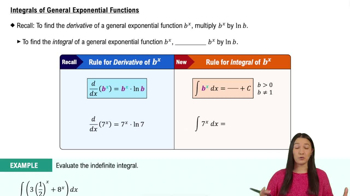If ƒ is an even function, why is ∫ᵃ₋ₐ ƒ(𝓍) d𝓍 = 2 ∫₀ᵃ ƒ(𝓍) d𝓍?
Table of contents
- 0. Functions7h 54m
- Introduction to Functions16m
- Piecewise Functions10m
- Properties of Functions9m
- Common Functions1h 8m
- Transformations5m
- Combining Functions27m
- Exponent rules32m
- Exponential Functions28m
- Logarithmic Functions24m
- Properties of Logarithms36m
- Exponential & Logarithmic Equations35m
- Introduction to Trigonometric Functions38m
- Graphs of Trigonometric Functions44m
- Trigonometric Identities47m
- Inverse Trigonometric Functions48m
- 1. Limits and Continuity2h 2m
- 2. Intro to Derivatives1h 33m
- 3. Techniques of Differentiation3h 18m
- 4. Applications of Derivatives2h 38m
- 5. Graphical Applications of Derivatives6h 2m
- 6. Derivatives of Inverse, Exponential, & Logarithmic Functions2h 37m
- 7. Antiderivatives & Indefinite Integrals1h 26m
- 8. Definite Integrals4h 44m
- 9. Graphical Applications of Integrals2h 27m
- 10. Physics Applications of Integrals 3h 16m
- 11. Integrals of Inverse, Exponential, & Logarithmic Functions2h 34m
- 12. Techniques of Integration7h 41m
- 13. Intro to Differential Equations2h 55m
- 14. Sequences & Series5h 36m
- 15. Power Series2h 19m
- 16. Parametric Equations & Polar Coordinates7h 58m
8. Definite Integrals
Average Value of a Function
Problem 5.4.50
Textbook Question
Symmetry of composite functions Prove that the integrand is either even or odd. Then give the value of the integral or show how it can be simplified. Assume f and g are even functions and p and q are odd functions.
∫ᵃ₋ₐ ƒ(p(𝓍)) d𝓍
 Verified step by step guidance
Verified step by step guidance1
Step 1: Recall the definitions of even and odd functions. An even function satisfies ƒ(𝓍) = ƒ(-𝓍), while an odd function satisfies ƒ(𝓍) = -ƒ(-𝓍). These properties will help us analyze the symmetry of the integrand.
Step 2: Analyze the composition ƒ(p(𝓍)). Since ƒ is an even function, ƒ(p(𝓍)) will depend on the behavior of p(𝓍). Because p is an odd function, p(-𝓍) = -p(𝓍). Substituting this into ƒ, we get ƒ(p(-𝓍)) = ƒ(-p(𝓍)).
Step 3: Use the property of ƒ being even. Since ƒ is even, ƒ(-p(𝓍)) = ƒ(p(𝓍)). Therefore, ƒ(p(𝓍)) satisfies ƒ(p(-𝓍)) = ƒ(p(𝓍)), which means the integrand ƒ(p(𝓍)) is an even function.
Step 4: Apply the symmetry property of definite integrals. For an even function integrated over a symmetric interval [-a, a], the integral simplifies to 2 times the integral from 0 to a. Specifically, ∫ᵃ₋ₐ ƒ(p(𝓍)) d𝓍 = 2∫₀ᵃ ƒ(p(𝓍)) d𝓍.
Step 5: Conclude the simplification. Since the integrand is even, the integral can be simplified as described in Step 4. If further evaluation is needed, substitute specific forms of ƒ and p into the integral and proceed with integration techniques.
 Verified video answer for a similar problem:
Verified video answer for a similar problem:This video solution was recommended by our tutors as helpful for the problem above
Video duration:
2mPlay a video:
Was this helpful?
Key Concepts
Here are the essential concepts you must grasp in order to answer the question correctly.
Even and Odd Functions
Even functions satisfy the property f(-x) = f(x) for all x, meaning their graphs are symmetric about the y-axis. Odd functions, on the other hand, satisfy f(-x) = -f(x), indicating symmetry about the origin. Understanding these properties is crucial for analyzing the symmetry of composite functions and their integrals.
Recommended video:

Properties of Functions
Composite Functions
A composite function is formed when one function is applied to the result of another function, denoted as (f ∘ g)(x) = f(g(x)). When dealing with even and odd functions, the symmetry properties of the outer and inner functions can affect the overall symmetry of the composite function, which is essential for determining the nature of the integrand.
Recommended video:

Evaluate Composite Functions - Special Cases
Integration of Symmetric Functions
When integrating even functions over symmetric intervals, the integral can be simplified to twice the integral from 0 to a, while the integral of odd functions over symmetric intervals equals zero. This property allows for easier computation of integrals involving even and odd functions, particularly in the context of the given problem.
Recommended video:

Integrals of General Exponential Functions

 6:37m
6:37mWatch next
Master Average Value of a Function with a bite sized video explanation from Patrick
Start learningRelated Videos
Related Practice
Textbook Question
30
views
